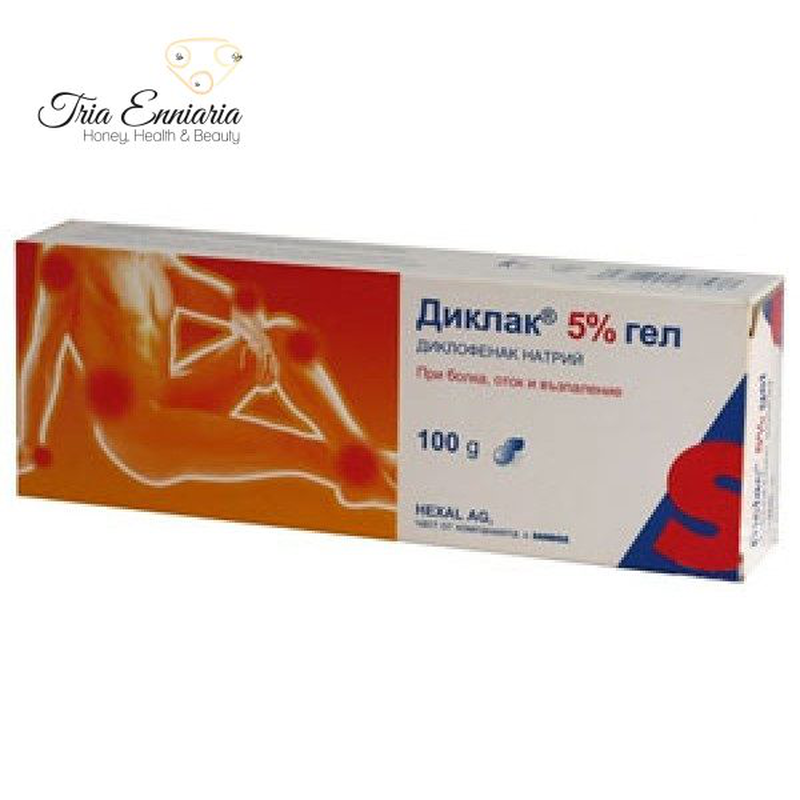In pain and inflammation of the joints-diclac 5%, 100g, sandoz

SANDOZ
In pain and inflammation of the joints-diclac 5%, 100g, sandoz
SANDOZ
In pain and inflammation of the joints-diclac 5%, 100g, sandoz
 Choose from available options.
Choose from available options.
Description
It is used for pain, inflammation and edema in:
- degenerative joint diseases /arthrosis of large and small joints/
- rheumatic soft tissue diseases /inflammation of tendons and ligaments, painful immobility of the shoulder, inflammation of muscles and joints/
- sports and domestic injuries /sprains, contusions, sprains/
Details
PRODUCT INFORMATION
Active substance: diclofenac sodium. 1 g of gel contains 50 mg diclofenac sodium.
The other ingredients are: hydroxypropylmethylcellulose, isopropyl alcohol, polyol ester and fatty acid, aromatic substance, purified water.
Diclac is an anti-inflammatory and anti-pain product.
Before using DICLAC: do not take Diclac: if you are allergic to diclofenac, acetylsalicylic acid, other non-steroidal anti-inflammatory drugs or any of the other ingredients of the medicinal product
Take special care when using Diclac: when administering Diclac 5% gel to patients suffering from asthma, hay fever, nasal polyps, chronic lung diseases or chronic respiratory system infections and patients with hypersensitivity to antifungal and anti-inflammatory drugs of any type, there is a higher risk of asthma attacks (T).pomegranate. intolerance to analgesics (analgesic asthma), local swelling of the skin and mucous membrane or urticaria than in other patients. In these patients, Dikak gel can only be used with certain precautions and direct follow-up by a doctor. The same applies to patients who develop allergic reactions and to other agents who experience skin reactions, itching or hives.
Diclac 5% Gel should only be applied to areas of skin with intact integrity, and should not be applied to injured skin or open wounds. Care should be taken that the gel does not come into contact with the eyes or mucous membranes.
Use of other medicines:
There are no known drug interactions with Diclac.
Children and adult patients:
Diclac Gel should not be used in children under 6 years of age, as there is no evidence of external use of diclofenac for this age group.
Pregnancy and lactation:
During the last three months of pregnancy and during breastfeeding, Diclac Gel should not be applied to large areas of the skin and for a longer period of time.
Driving and using machines:
No effects on the ability to drive or use machines are known to date.
Important information about some of the ingredients of Diclac:
Diclac gel contains alcohol /isopropyl alcohol/ and therefore should not be in contact with open wounds, mucous membranes or eyes.
HOW TO USE DICLAC:
Dosage is recommended if your doctor has not prescribed Diclac gel in another dosing regimen.
Diclac gel is applied on a thin layer on the corresponding areas of the skin 2-3 times a day.
Rub into the skin. Do not take by mouth.
Diclac gel is suitable for use in ionophoresis. This form of electrotherapy enhances penetration through the skin. Diclac Gel should be applied at negative pole / cathode/.
The product can be administered for 3 to 7 days depending on the case.
POSSIBLE SIDE EFFECTS:
Uncommon local skin reactions such as itching, redness, skin rashes, burning of the skin , development of oedema, blistering, peeling, and skin dryness may occur.
If Diclac is applied to a large area of the skin and for a longer period of time, as well as with diclofenac-containing tablets, suppositories or ampoules, systemic side effects may be observed. Gastrointestinal disorders, Generalised skin rash, hypersensitivity reactions in the form of angioedema and difficulty breathing, and sensitivity to light have been reported in isolated cases.
If you notice any side effects not mentioned in this leaflet, please tell your doctor.
Manufacturer:SANDOZ - HEXAL AG